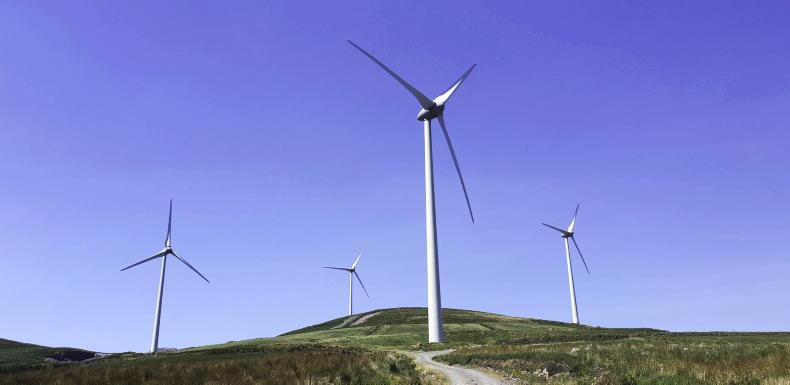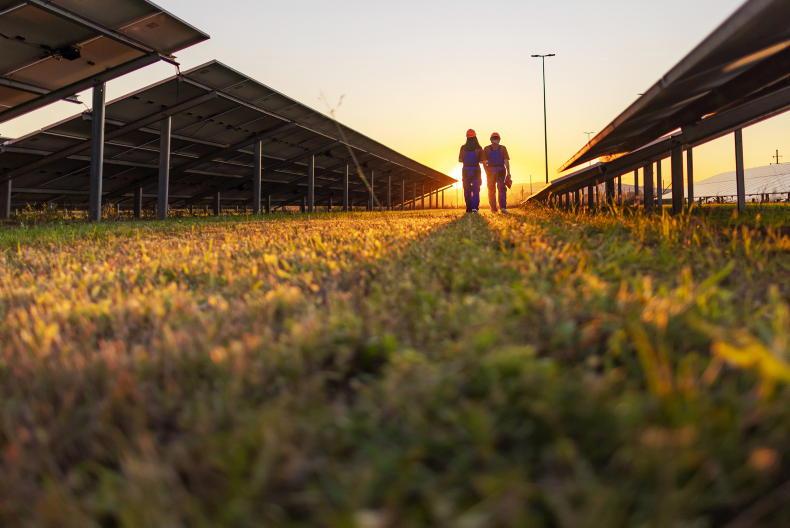Over 270,000 farmers and members of the public attended last week’s National Ploughing Championships. While the mood was generally upbeat, many were turning their attention to the upcoming 2023 season.
The deepening energy crisis and its increasing cost is set to play a major role in the coming year so, naturally, interest in renewable energy technologies was at an all-time high.
Exhibitors and suppliers of renewable technology, solar PV in particular, reported a record number of leads.
However, despite the economics of solar PV improving significantly, and an ambitious Government target of 380MW of rooftop generation by 2030, there are still many questions around the technology. This are article sums up the key questions which were asked by farmers at the event.
How do they work?
Solar photovoltaic (PV) modules generate direct current (DC) electricity when exposed to light. Solar PV systems are generally rated in kilowatts (kW) and this describes their electrical output at peak generation.
A 1kW solar PV system would typically require three to four solar panels on your roof. Each panel is around 1.6m2 in size.
Do solar PV panels generate electricity all year round?
Yes, solar PV systems will generate electricity when there is daylight, so they will still function during cloudy, wet and rainy days. However, it is unlikely that they will generate to their maximum rated output during these conditions.
Around 75% of the annual energy from a solar PV system is produced from May to September, during the typically sunnier months.
How do I size my solar PV system?
The size of the system depends on your farm’s energy usage, the amount of sunlight you receive, your farm’s grid connection, the type of solar panel, other generators in the area, your maximum import capacity and how much you are willing to invest.
Most suppliers will walk you through what size of system is suited to your farm, but if your energy bill is over €10,000 per annum you can avail of a Sustainable Energy Authority of Ireland (SEAI) energy audit grant which will help you determine this (registered farm companies and partnerships only).
Depending on energy demand, farms on single phase can install a system up to 17kW in output while farms on three-phase can install up to 50kW.
Do I need planning permission?
Rooftop solar PV systems are exempt from needing planning permission if they do not exceed 50m2 or 50% of the total roof area, whichever is the lesser. Ground mounted solar systems are exempt if they are under 25m2. These thresholds are anticipated to increase, however.
What is an inverter?
When sunlight hits the solar panels, the type of electricity generated is referred to as direct current (DC). However, the electricity used to power items is usually in alternating current form (AC). An inverter converts DC to AC electricity.
Are batteries useful?
Yes, in many situations, batteries are useful. Batteries can be charged using the solar electricity which isn’t being used, typically during off-peak hours, and then discharge it when its needed (normally that evening/night). However, every other method of using or storing solar electricity should be used first before considering batteries, ie heating water in a tank.
Can I export back to the grid?
Yes but this is still an emerging area. The ESB Networks has launched a new grid connection process to allow larger solar PV systems to export electricity back to the grid. This is called NC-7 and can be found on the ESB Networks’ website. Up to 50kW can be exported under this process.
Can I get paid for what I export back to the grid?
Again, this is an evolving area. There are currently a number of short contracts available from energy suppliers to purchase electricity which is exported back to the grid. Up to 20c/kWh is available from some suppliers. But the number of farmers who are actually doing this is small.
A new State-backed Clean Export Premium, which would offer payments for exported electricity for up to 15 years, was announced last December but has yet to be launched.
The price for this was set at €13.5c/kWh which many argue is too low.
Does panel efficiency decrease over time?
Yes. Solar panels have an operational lifetime of between 20 and 30 years but panel efficiency decreases over time. The rate of efficiency decrease depends on the quality of the panel and could range from 0.35% to 0.75% per annum.
What maintenance is involved?
PV systems are low-maintenance, but not zero maintenance. You should monitor the performance of your system regularly. Get an idea from your installer about how much the PV system should generate each year. Then see if your system is generating close to that.
The solar panels themselves are robust, but should be cleaned once a year when installed on a farm.
When choosing which panels to install, the environment needs to be taken into account. In particular, you need to ensure that your panels are fully warranted against damage by ammonia gases and harsh weather conditions.
The inverter and the batteries are the only components that may require to be changed in five to 10 years.
Does roof orientation make a difference?
South-facing slopes generally maximise electricity generation.
However, another option is to install a PV system which faces west and/or east. This will provide more energy in the morning or the evening which may better suit the demand of some farmers, namely those in the dairy sector.
See Figure 1 for an example of peak energy demand on a 100-cow dairy farm. However, an east/west-facing PV system will generate less energy over the year than a south-facing system.
Can I develop a larger solar project on my farm?
A new Small Scale Generation Scheme is currently in development, which may make this feasible. The public consultation on the scheme is due to end next month.
What grants are available?
Currently, grants of between 40% and 60% are available under TAMS for solar PV systems up to 11kW and 6kW of battery storage. However, pig and poultry farmers are grant-aided on a m2 basis. Farmers who avail of TAMS still cannot export excess electricity to the grid.
The SEAI also has grants of up to €2,500 available for small solar PV installations.
The SEAI runs the Excellence in Energy Efficiency Design (EXEED) programme which provides larger grants to companies planning an investment in an energy project. It can cover 50% to 70% for external consultancy support and 30% to 50% of the capital cost of projects. The maximum funding is €1m.
The SEAI Better Energy Communities grant can also cover up to 30% of total costs for a community project.
What’s the payback period?
Every farm and situation is different and system costs vary depending on brand and size.
For example, a 15kW system could cost up to €12,500 while a 50kW system could cost up to €65,000 (plus VAT).
High energy users, who avail of grant aid and use most home-produced electricity on-farm could see playback periods of 2.5 to four years. Those who are reliant on making a return from selling electricity to the grid could see a payback period of five to 10 years.
The use of accelerated capital allowances (a tax incentive aimed at companies paying corporation tax, sole-traders and non-corporates) and claiming VAT back, along with availing of grants, dramatically reduce the payback period.
Over 270,000 farmers and members of the public attended last week’s National Ploughing Championships. While the mood was generally upbeat, many were turning their attention to the upcoming 2023 season.
The deepening energy crisis and its increasing cost is set to play a major role in the coming year so, naturally, interest in renewable energy technologies was at an all-time high.
Exhibitors and suppliers of renewable technology, solar PV in particular, reported a record number of leads.
However, despite the economics of solar PV improving significantly, and an ambitious Government target of 380MW of rooftop generation by 2030, there are still many questions around the technology. This are article sums up the key questions which were asked by farmers at the event.
How do they work?
Solar photovoltaic (PV) modules generate direct current (DC) electricity when exposed to light. Solar PV systems are generally rated in kilowatts (kW) and this describes their electrical output at peak generation.
A 1kW solar PV system would typically require three to four solar panels on your roof. Each panel is around 1.6m2 in size.
Do solar PV panels generate electricity all year round?
Yes, solar PV systems will generate electricity when there is daylight, so they will still function during cloudy, wet and rainy days. However, it is unlikely that they will generate to their maximum rated output during these conditions.
Around 75% of the annual energy from a solar PV system is produced from May to September, during the typically sunnier months.
How do I size my solar PV system?
The size of the system depends on your farm’s energy usage, the amount of sunlight you receive, your farm’s grid connection, the type of solar panel, other generators in the area, your maximum import capacity and how much you are willing to invest.
Most suppliers will walk you through what size of system is suited to your farm, but if your energy bill is over €10,000 per annum you can avail of a Sustainable Energy Authority of Ireland (SEAI) energy audit grant which will help you determine this (registered farm companies and partnerships only).
Depending on energy demand, farms on single phase can install a system up to 17kW in output while farms on three-phase can install up to 50kW.
Do I need planning permission?
Rooftop solar PV systems are exempt from needing planning permission if they do not exceed 50m2 or 50% of the total roof area, whichever is the lesser. Ground mounted solar systems are exempt if they are under 25m2. These thresholds are anticipated to increase, however.
What is an inverter?
When sunlight hits the solar panels, the type of electricity generated is referred to as direct current (DC). However, the electricity used to power items is usually in alternating current form (AC). An inverter converts DC to AC electricity.
Are batteries useful?
Yes, in many situations, batteries are useful. Batteries can be charged using the solar electricity which isn’t being used, typically during off-peak hours, and then discharge it when its needed (normally that evening/night). However, every other method of using or storing solar electricity should be used first before considering batteries, ie heating water in a tank.
Can I export back to the grid?
Yes but this is still an emerging area. The ESB Networks has launched a new grid connection process to allow larger solar PV systems to export electricity back to the grid. This is called NC-7 and can be found on the ESB Networks’ website. Up to 50kW can be exported under this process.
Can I get paid for what I export back to the grid?
Again, this is an evolving area. There are currently a number of short contracts available from energy suppliers to purchase electricity which is exported back to the grid. Up to 20c/kWh is available from some suppliers. But the number of farmers who are actually doing this is small.
A new State-backed Clean Export Premium, which would offer payments for exported electricity for up to 15 years, was announced last December but has yet to be launched.
The price for this was set at €13.5c/kWh which many argue is too low.
Does panel efficiency decrease over time?
Yes. Solar panels have an operational lifetime of between 20 and 30 years but panel efficiency decreases over time. The rate of efficiency decrease depends on the quality of the panel and could range from 0.35% to 0.75% per annum.
What maintenance is involved?
PV systems are low-maintenance, but not zero maintenance. You should monitor the performance of your system regularly. Get an idea from your installer about how much the PV system should generate each year. Then see if your system is generating close to that.
The solar panels themselves are robust, but should be cleaned once a year when installed on a farm.
When choosing which panels to install, the environment needs to be taken into account. In particular, you need to ensure that your panels are fully warranted against damage by ammonia gases and harsh weather conditions.
The inverter and the batteries are the only components that may require to be changed in five to 10 years.
Does roof orientation make a difference?
South-facing slopes generally maximise electricity generation.
However, another option is to install a PV system which faces west and/or east. This will provide more energy in the morning or the evening which may better suit the demand of some farmers, namely those in the dairy sector.
See Figure 1 for an example of peak energy demand on a 100-cow dairy farm. However, an east/west-facing PV system will generate less energy over the year than a south-facing system.
Can I develop a larger solar project on my farm?
A new Small Scale Generation Scheme is currently in development, which may make this feasible. The public consultation on the scheme is due to end next month.
What grants are available?
Currently, grants of between 40% and 60% are available under TAMS for solar PV systems up to 11kW and 6kW of battery storage. However, pig and poultry farmers are grant-aided on a m2 basis. Farmers who avail of TAMS still cannot export excess electricity to the grid.
The SEAI also has grants of up to €2,500 available for small solar PV installations.
The SEAI runs the Excellence in Energy Efficiency Design (EXEED) programme which provides larger grants to companies planning an investment in an energy project. It can cover 50% to 70% for external consultancy support and 30% to 50% of the capital cost of projects. The maximum funding is €1m.
The SEAI Better Energy Communities grant can also cover up to 30% of total costs for a community project.
What’s the payback period?
Every farm and situation is different and system costs vary depending on brand and size.
For example, a 15kW system could cost up to €12,500 while a 50kW system could cost up to €65,000 (plus VAT).
High energy users, who avail of grant aid and use most home-produced electricity on-farm could see playback periods of 2.5 to four years. Those who are reliant on making a return from selling electricity to the grid could see a payback period of five to 10 years.
The use of accelerated capital allowances (a tax incentive aimed at companies paying corporation tax, sole-traders and non-corporates) and claiming VAT back, along with availing of grants, dramatically reduce the payback period.









SHARING OPTIONS